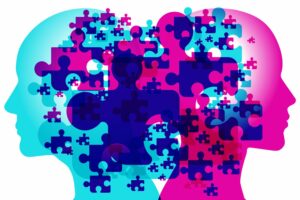Psychodynamic psychiatry is a form of psychotherapy that delves into the depths of the human mind to explore the unconscious factors that shape our behavior, thoughts, and emotions. Based on the work of Sigmund Freud, this approach seeks to help individuals gain insight into unresolved conflicts from their past and find ways to overcome them in the present. In this article, we will delve into the principles, techniques, and applications of psychodynamic psychiatry. We will also explore its role in modern-day mental health treatment.
Contents
What is Psychodynamic Psychiatry?

Psychodynamic psychiatry is a form of psychotherapy that emphasizes the role of the unconscious mind in shaping a person’s behavior, thoughts, and emotions. The underlying theory of psychodynamic psychiatry is that unresolved conflicts from a person’s past can manifest in their present behaviors and relationships. The goal of psychodynamic psychiatry is to help individuals gain insight into these unconscious conflicts and find ways to resolve them.
History of Psychodynamic Psychiatry
The origins of psychodynamic psychiatry can be traced back to the work of Sigmund Freud, who developed the theory of psychoanalysis in the late 1800s. Freud believed that human behavior was driven by unconscious motives and that people could gain insight into these motives through the process of free association. This involved talking about one’s thoughts and feelings without censorship or judgment.
Freud’s theories were controversial at the time, and many of his ideas were challenged by other prominent psychiatrists and psychologists of the day. However, his work laid the foundation for modern psychodynamic psychiatry, incorporating many of his core concepts and ideas.
Principles of Psychodynamic Psychiatry
Psychodynamic psychiatry is based on several key principles that shape its approach to psychotherapy. These principles include:
- Unconscious Mind: Psychodynamic psychiatry believes that much of our behavior is driven by unconscious impulses, thoughts, and emotions that are beyond our conscious awareness.
- Childhood Development: This psychiatry posits that early childhood experiences play a crucial role in shaping our personality and behavior as adults. Trauma or unresolved conflicts from our past can affect our present behavior and relationships.
- Defense Mechanisms: The unconscious mind employs defense mechanisms to protect us from unpleasant thoughts or emotions. These mechanisms, however, can sometimes be maladaptive and contribute to psychological problems.
- Insight and Self-Awareness: The goal of this psychiatry is to help individuals gain insight into their unconscious conflicts and find ways to resolve them. Through this process, individuals can develop greater self-awareness and make positive changes in their lives.
- Transference and Countertransference: This psychiatry acknowledges the importance of the therapeutic relationship between the therapist and the patient. Transference occurs when the patient unconsciously projects feelings or attitudes onto the therapist, while countertransference refers to the therapist’s emotional responses to the patient. These dynamics can be explored in therapy to gain insight into the patient’s interpersonal relationships.
- Resistance: Resistance refers to the patient’s unwillingness or difficulty in exploring specific topics or emotions in therapy. This psychiatry views resistance as a defense mechanism and a potential window into the patient’s unconscious conflicts.
These principles form the foundation of psychodynamic psychiatry and guide its approach to understanding and treating psychological problems.
Psychodynamic Techniques

Psychodynamic psychiatry employs a variety of techniques to help individuals gain insight into their unconscious conflicts and develop greater self-awareness. Some of the most common psychodynamic techniques include:
- Free Association: Free association involves patients talking freely and spontaneously about their thoughts, emotions, and experiences. The therapist listens actively, without judgment or interruption, and helps the patient explore the underlying meanings of their associations.
- Dream Analysis: Dreams are thought to be a window into the unconscious mind. Psychodynamic psychiatrists may use dream analysis to help individuals gain insight into their unconscious conflicts and desires. Patients are encouraged to share their dreams with the therapist, who helps them explore the symbolic meanings of the dream.
- Interpretation: Interpretation involves the therapist offering insights and explanations for a patient’s behavior, thoughts, and emotions. This can help the patient gain insight into their unconscious conflicts and develop greater self-awareness. Interpretation can take many forms, such as exploring the symbolic meanings of a patient’s dreams or analyzing patterns of behavior in the therapeutic relationship.
- Transference: Furthermore, Transference occurs when a patient unconsciously projects feelings or attitudes onto the therapist, often based on past experiences. Psychodynamic psychiatrists may use transference to help individuals gain insight into their relationships and how they may be impacted by past experiences.
- Countertransference: Countertransference refers to the therapist’s emotional responses to the patient. This can include feelings of empathy, anger, or frustration. Psychodynamic psychiatrists may use their countertransference responses to help patients gain insight into their interpersonal relationships and dynamics.
- Working Through: Working through involves exploring and resolving unconscious conflicts and defense mechanisms. This can be a challenging and time-consuming process, but it is essential for long-term personal growth and change.
These techniques are often used in combination, depending on the individual patient’s needs and goals.
Applications of Psychodynamic Psychiatry
Psychodynamic psychiatry has been used to treat a wide range of mental health conditions, including depression, anxiety, personality disorders, and addiction. The application of psychodynamic principles and techniques can help individuals develop insight into the underlying causes of their problems, leading to greater self-awareness and personal growth.
Some specific applications of psychodynamic psychiatry include:
- Depression: Furthermore, Psychodynamic psychiatry can help individuals explore the underlying causes of their depression, such as unresolved childhood trauma, and develop strategies for managing and overcoming their symptoms.
- Anxiety: Furthermore, Psychodynamic psychiatry can help individuals identify and understand the unconscious fears and anxieties that drive their symptoms, such as phobias or panic attacks.
- Personality Disorders: Furthermore, Psychodynamic psychiatry can help individuals with personality disorders, such as borderline personality disorder, gain insight into the underlying causes of their maladaptive behaviors and develop more adaptive coping strategies.
- Addiction: Furthermore, Psychodynamic psychiatry can help individuals explore the unconscious motivations and emotions that drive their addictive behaviors and develop strategies for overcoming them.
- Interpersonal Relationships: Furthermore, Psychodynamic psychiatry can help individuals gain insight into their interpersonal relationships and how they may be impacted by past experiences or unconscious conflicts. This can lead to greater self-awareness and healthier relationships.
Furthermore, Psychodynamic psychiatry is not a one-size-fits-all approach, and different individuals may benefit from different therapeutic approaches.
Pros of Psychodynamic Psychiatry

Psychodynamic psychiatry has several potential benefits for individuals seeking mental health treatment. Here are some of the pros of psychodynamic psychiatry:
- Addresses Underlying Causes: Furthermore, psychodynamic psychiatry seeks to identify and address the underlying causes of psychological problems, rather than simply treating symptoms. This can lead to more lasting and meaningful change.
- Holistic Approach: Furthermore, Psychodynamic psychiatry takes a holistic approach to mental health treatment, recognizing the importance of early childhood experiences, unconscious conflicts, and interpersonal relationships in shaping an individual’s behavior and emotions.
- Promotes Self-Awareness: Furthermore, psychodynamic psychiatry promotes self-awareness and insight into one’s unconscious conflicts, which can lead to greater self-understanding and personal growth.
- Relationship-Focused: Furthermore, psychodynamic psychiatry emphasizes the importance of the therapeutic relationship between the patient and therapist, which can help individuals develop healthier relationships in their personal lives.
- Applicable to a Wide Range of Conditions: Furthermore, psychodynamic psychiatry can be used to treat a wide range of mental health conditions, including depression, anxiety, personality disorders, and addiction.
- Long-Term Benefits: Further, psychodynamic psychiatry can lead to long-term benefits, as individuals develop insight into their unconscious conflicts and learn how to manage them in their daily lives.
Cons of Psychodynamic Psychiatry

While psychodynamic psychiatry can offer several benefits, there are also some potential drawbacks or cons to consider. Here are some of the cons of psychodynamic psychiatry:
- Time-Intensive: Furthermore, Psychodynamic psychiatry can be a time-intensive process, with therapy sessions often lasting 45-60 minutes and requiring a significant commitment of time and resources.
- Expensive: Furthermore, Because of the time-intensive nature of psychodynamic psychiatry. It can also be expensive, particularly if insurance coverage is limited.
- Limited Evidence: Furthermore, While there is some evidence to support the effectiveness of psychodynamic psychiatry, there are fewer controlled studies than other forms of therapy, such as cognitive-behavioral therapy.
- Lack of Focus on Symptom Relief: Furthermore, Psychodynamic psychiatry is not always focused on symptom relief, which can be frustrating for individuals seeking immediate relief from their psychological problems.
- Focus on Past Trauma: Furthermore, Psychodynamic psychiatry can focus heavily on past trauma and experiences, which can be difficult and painful for individuals to revisit.
- Potential for Dependence: Furthermore, The focus on the therapeutic relationship and the potential for transference can create a dependence on the therapist, which can make it difficult for individuals to transition away from therapy.
Overall, psychodynamic psychiatry can offer several benefits, but it may not be the right approach for everyone.
Conclusion
In conclusion, psychodynamic psychiatry is a branch of psychiatry that focuses on the role of unconscious processes and early life experiences in shaping a person’s behavior, emotions, and relationships. It emphasizes the importance of the therapeutic relationship between patient and therapist in uncovering and resolving unconscious conflicts and developmental issues.
By exploring the unconscious sources of a patient’s symptoms and problems, psychodynamic psychiatry seeks to promote self-awareness, insight, and personal growth. It offers a unique perspective on the human mind and the complex factors influencing our thoughts, feelings, and behaviors.
For more information, please contact MantraCare. A psychiatrist is a medical doctor who specializes in the diagnosis, treatment, and prevention of mental illnesses and emotional disorders. If you have any queries regarding Online Counseling experienced therapists at MantraCare can help: Book a trial therapy session.


